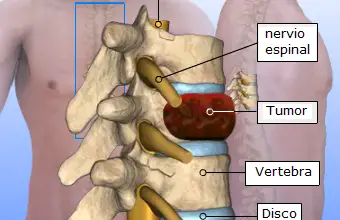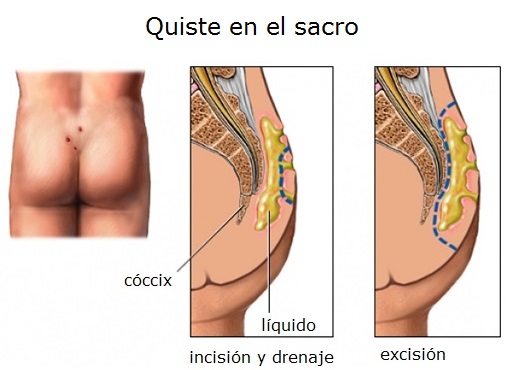As in other parts of the body, tumors and cysts tooéThey can develop in the entire area of the spine, there are benign and malignant and thenówe present them to you.

Index
Spinal tumor types
Bone aneurysmal cyst
These are not actually tumors; are cysts that can be seen and treated like tumors, occur most often in the lumbar spine area.
There is a higher incidence in women than in men and the highestía are discovered when the patient isá in his teens or with a few 20 años.
c tumorégiant squid
This very aggressive tumor is found más frequently in the áareas of the sacrum and the anterior part of the vertebral column. Patients who have máThe chances of suffering from it are women between the ages of 30 and 40 años.
This type of benign tumor is often found in areas torácica and lumbar and has más likely to affect women between the ages of 30 and 40 años.
It is usually benign and does not cause anyúno problem at mostía of the cases.
Osteoma osteoide
This type of tumor is relatively commonún, especially in men between 20 and 40 añyou of age. They are often found in the back of the lumbar spine. These types of tumors sometimes cause spinal deformity.
These tumors are similar to osteoid osteomas but are más large, mábe aggressive and, luckily it is not soún.
There is a higher incidence in men between 20 and 30 añyears of age and are most often found in the posterior area of the lumbar spine.
Variety of primary malignant tumors of the spine
These include:
- Tumors are little típeaks, of slow growth that are generally found in male patients between the ages of 50 and 70. These types of tumors are found más comúnly in the sacrum and resectionón wantúrgica is mandatory. Because these tumors are often in close proximity to raícessation of nerves, the cirugía sometimes it also impliesén la eliminationónumber of nerves affected.
- These tumors are rare, but often appear in male jóyou come. They are usually highly malignant and spread fáeasily to others áareas of the body.
- They are slow-growing tumors and are often found in areas torácat, lumbar and sacral spine. The patients más prone are men older than 40 años. Some of these tumors cannot be removed surgically.úrigidly due to its positionón in column, but a removalón wantúAdequate surgical therapy is key to the long-term survival of the patient. Además, These tumors do not always respond well to chemotherapy or radiation.ón.
- Spaghettiéthey are not called “c tumorséround squid” due to its appearance under the microscope. They may appear as a single tumor or as múmultiples. In general, They are found in the tor areasácica or lumbar spine in men older than 50.
Myeloma múmultiple
are alsoéNo tumors “decéround squid” and they are the type más comúno of cábone cancer in adults. Patients are usually older, with around 50 and 80 añyou of age. These tumors usually respond well to chemotherapy and radiation.ón.
These tumors “decéround squid” are have a higher incidence and are often found in múmultiples áareas of the body. The patients más prone to suffer from themán between the ages of 40 and 60.
Sarcoma de Ewing
It is a tumor of céhighly malignant round lulas that attacks most frequently in niños. in the majoríto of the cases sitústill in the sacral area of the spine. Unfortunately, the survival rate per más de 5 años is less than 20 % for patients with this type of tumor.
Spinal tumors alsoécan not be caused for the cácancer that has spread from other áareas of the body. The way the cáncer remains unclear.
Nevertheless, every yearñthe approximately 1 millón of new cases of cáncer are diagnosed and the skeletal systemético, including the spine, It's the third área más frequent to which it extends.
Any kind of cáCancer can spread to the spine. Más frequently occurs with the following types of cáncer:
- The cálung cancerón
- The cáI'm waiting for my mother
- The cáncer de próstata
- The cáthyroid cancer
- The cáncer de riñón

The sísymptoms of a spinal tumor
Benign and malignant tumors of the spine almost always present with Back pain, éthis is the símy youtháit's important.
Coincidentally, back pain is alsoén the sívery common symptom of other non-tumor disorders of the spine.
An injuryón in the lower back due to sprain/tear, whiplash, herniated disc, and spinal stenosis are examples of back problems frequently related to pain.
While it is normal for back or neck pain to cause concern,ón, there are various signs and sísymptoms that suggest it is time to see your méI say confident when:
Back pain is…
- Sudden, intolerable, and / or persistent
- Worsenápiously
- It's worse at night
- It is present when it is notás active
- Radiates (spreads to other parts of the body)
Other signs and síntomas…
- Dificulty to walk
- Muscular weakness
- decreaseón of sensitivity to heat and fríO
- Spinal deformity (for instance, not related to posture – an abnormal curvature of the spine)
- Dysfunctionóno bowel or bladder (for instance, péloss of control)
- Parálysis
Often, pain caused by a tumor in the spine (either benign or malignant) it's meás pronounced at night and not relieved by rest.
If you experience any of these sísymptoms of tumors, commoníSee your healthcare professional immediately.

2 thoughts on “Tumors and cysts in the spine”
Comments are closed.